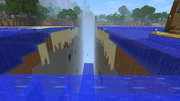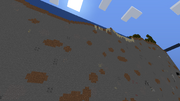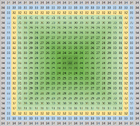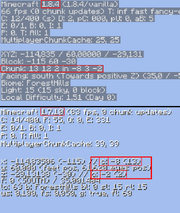How Big Is One Minecraft Chunk

Visualization of the ground portion of a single clamper. The entire clamper extends up to a meridian of 320.
A chunk is a 384-cake tall 16×16 segment of a earth. Chunks are the method used by the world generator to separate maps into manageable pieces.
Generation [ ]
Chunks are 16 blocks wide, xvi blocks long, 384 blocks high, and 98,304 blocks total. They extend from the bottom of the world, Y=-64, all the way upward to the build limit of Y=320. Chunks generate effectually players when they first enter the world. As they wander around the world, new chunks generate as needed.
Chunks generate with the help of the map seed, which ways that the chunks are e'er the same if yous would utilise the same seed once again, every bit long as the map generator and version number remain the same.
Spawn chunks, a 19x19 ready of chunks around the world spawn, are always loaded, so you can use that to your advantage when making automatic farms.
Chunk loading [ ]

Unloaded chunks in water.

Unloaded chunks on land.

A purlieus between loaded and unloaded chunks.
Since Minecraft worlds are 30 million blocks in each cardinal management and contain an farthermost amount of chunks, the game loads only certain chunks in order to brand the game playable.
Unloaded chunks are unprocessed by the game and do not process any of the game aspects.
Please notation that events that tin happen when a chunk is loaded, is not the aforementioned as events that simply happen effectually the player. For example, normal mob spawning and random tick (determines crop growth, etc.) can only happen near a player, and volition not happen in loaded chunks far away from any players.
Coffee Edition [ ]
Tickets [ ]
Loading starts when a chunk receives ticket. All loaded chunks originate from the ticket.
Each load ticket has 3 properties: Level, Ticket blazon and (optionally) Fourth dimension to Live.
Level and load type [ ]
Levels are numbers that determine what load type the chunk is.
Load levels range from 22 to 44 in regular gameplay, while only 22 to 33 are relevant. Load levels less than 22 (including negative levels) are valid but simply possible with a modded game. Load levels above 44 are not possible in vanilla. Even so, it could exist possible by modifying the in-game code.
For a given clamper, but its lowest level matters. (Lower levels = higher load type.)
There are four chunk load types; each load type has different properties. This excludes unloaded chunks.
| Load Type | Level | Backdrop | |
|---|---|---|---|
| Entity Ticking | 31 and below | All game aspects are active. | |
| Ticking | 32 | All game aspects are active except that entities are not processed (do not motility) and chunk ticks aren't either. | |
| Edge | 33 | Only some game aspects are active (Redstone and command blocks do not work). | |
| Inaccessible | 34 and higher up | No game aspects are active, simply world generation however occurs. | |
Level propagation [ ]
Load levels "propagate" or menses from source clamper with a ticket to neighboring chunks, merely each time it increases its Level by 1 until the maximum of 44.
The chunks that get load level from level expansion activate the assigned load type.
| 34 | 34 | 34 | 34 | 34 | 34 | 34 |
| 34 | 33 | 33 | 33 | 33 | 33 | 34 |
| 34 | 33 | 32 | 32 | 32 | 33 | 34 |
| 34 | 33 | 32 | 31 | 32 | 33 | 34 |
| 34 | 33 | 32 | 32 | 32 | 33 | 34 |
| 34 | 33 | 33 | 33 | 33 | 33 | 34 |
| 34 | 34 | 34 | 34 | 34 | 34 | 34 |
| IN | IN | IN | IN | IN | IN | IN |
| IN | BO | BO | BO | BO | BO | IN |
| IN | BO | TI | TI | TI | BO | IN |
| IN | BO | TI | ET | TI | BO | IN |
| IN | BO | TI | TI | TI | BO | IN |
| IN | BO | BO | BO | BO | BO | IN |
| IN | IN | IN | IN | IN | IN | IN |
Ticket types [ ]
In that location are different ticket types, which come from various sources and activate chunks with unlike load types.
- Role player ticket
This ticket is acquired by the player and is assigned level 31. A player ticket is given to each chunk inside an area surrounding the player every bit divers by the formulas described below and propagates as described in the table in a higher place.
In singleplayer, the chunk loading altitude is 1 less than the render distance, as configured in Options. It follows the formula (2r - 3)two = AoC where r is the selected render distance, and AoC is the area of chunks that are assigned an original player ticket (level 31 - entity ticking). The minimum AoC is 9, which ways that there is no divergence between having the return altitude set to 2 or 3.
For example, in a single-actor game with a return altitude of 5 chunks, an area of 7×seven chunks centered around the player has a load type of entity ticking (level 31) the immediately enclosing chunks. The strip of chunks at the outer edge of a ix×9 perimeter surrounding the playe accept ticking (level 32), and the next enclosing chunks (11×11 perimeter) are edge chunks (level 33).
In multiplayer, the chunk loading altitude is equal to the view-altitude, as configured in server.properties. It follows the formula (25 + one)2 = AoC where five is the configured view-distance, and AoC is the area of chunks that are assigned an original thespian ticket (level 31 - entity ticking).
For example, in a multiplayer server with a configured view-distance of 5 chunks, an area of xi×11 chunks centered effectually the player has a load type of entity ticking (level 31), while the immediately enclosing chunks. The strip of chunks at the outer edge of a 13×xiii perimeter surrounding the histrion accept ticking (level 32), and the next enclosing chunks (xv×fifteen perimeter) are border chunks (level 33).
- Forced ticket
A ticket can also exist created by using the /forceload command. It has a level of 31, then its propagation can be seen in the tabular array higher up.
Chunks remain force-loaded even later closing and opening the game.
- Outset ticket

Propagation of start ticket
Ticket created by the earth spawn for the clamper it is located at ("spawn chunks"). Its position can be changed by a /setworldspawn command. It has a level of 22, the lowest in the game. They are active whenever the player is in the Overworld and are otherwise permanently active.
- Portal ticket
Ticket created when an entity is teleported through nether portal, given to clamper at the other side of the portal. It has a level of 30, so it is stronger than the player/force loaded ticket.
Information technology expires afterward 300 game ticks (equivalent to 15 seconds). Considering they are created each fourth dimension an entity passes through the portal, information technology is possible to create a "clamper loader". Perpetually keeping chunks loaded without the player existence well-nigh, which can exist used for various in-game mechanics such every bit farms, simply tin can create lag.
- Dragon ticket
Ticket created at the start of the battle with ender dragon and is given to the 0,0 chunk (the one with leave portal). It has a level of 24.
It expires subsequently no more players participate in the battle, or the dragon dies.
- Post-teleport ticket
Ticket created when entity is teleported either by going through the end portal or using /teleport or /spreadplayers commands. The /teleport command has a level of 32, whereas, for /spreadplayers and the end portal, it has a level of 33.
It expires after 5 game ticks.
- Temporary ticket
Ticket created when an capricious piece of game lawmaking calls getChunk. If the game code says the chunk should be loaded, it places this ticket on that chunk (after possibly creating it).
The load level depends on what kind of chunk the game attempts to load (a fully earth-generated clamper or non). It is always level 33 (border) or greater. In many cases, it involves world generation in some way.
For example, when a generic mob wandering AI is executing, information technology asks if a certain block has a solid top surface. As function of that check, that chunk has an "unknown" ticket with level 33 placed on it. Similarly, commands such as /clone, /information, /execute (if|unless) (block|blocks|predicate), /make full and /setblock generate a temporary ticket when reading data from or writing it to a previously loaded chunk; if run every tick, they can prevent the chunk from unloading until the earth is reloaded.[i]
Information technology expires later 1 game tick.
- Light ticket
Unknown, peradventure world-generation related.
Limitations [ ]
- Idle timeout
-
- Each dimension has its own idle timeout. If there are players or forceloaded chunks in the dimension, the timeout is disabled. When entity leaves or enters this dimension, the timeout is reset.
- If the timeout reaches 300 game ticks, the dimension stops processing sure deportment. These include entity and block entity ticking, ender dragon fight, and global entities (lightning).
- Some game aspects don't always become processed in loading chunks considering there may be other atmospheric condition for their progress, which includes the following:
- Chunk tick
- Only chunks with centers inside 128 blocks of a player are ticked on every game tick. See as well Tick.
- Entities
- Hostile mobs instantly despawn if they spawn more than than 128 blocks from any player.
- This includes zombified piglins at Nether portals and witches in witch huts.
- Passive mobs do non spawn naturally exterior a 240 block X 240 cake area around a player.
- The passive mob spawn cap is limited past the number of friendly mobs loaded into memory, which means that any passive mobs nowadays in the spawn chunks count toward the mob cap and usually prevents friendly mobs from naturally spawning anywhere else in the world. The only exception is when passive mobs spawn as part of a newly generated clamper.
- See also Spawn.
- Hostile mobs instantly despawn if they spawn more than than 128 blocks from any player.
- Chunk tick
Exceptions [ ]
Events in a chunk may affect blocks in outside chunks. If the outside chunk is inactive, the effects are suspended in nigh cases. Specifically,
- Block changing on the edge of a ticking chunk can spread updates to blocks exterior the ticking clamper and brand them respond appropriately. The update may be propagated block by block until outside the border chunks, at which time information technology creates a temporary ticket to continue propagation.
- Block in a chunk with a 33 level can request a scheduled tick, just information technology does non get processed until the chunk gets a load level of 32 or below.
- Flowing h2o or lava tin can spread to the beginning adjacent block exterior a ticking chunk, but the menstruation becomes suspended there until the border chunk has a greater load level.
- Burn down can spread to the first adjacent flammable block outside the ticking chunk. Like h2o and lava, it becomes suspended there. It cannot spread further until the outside chunk gets a level of 33 or below.
- Grass and mycelium tin can spread to the first adjacent cake outsider an entity ticking clamper.
- Pumpkin and melon stem growing on the edge of an entity ticking clamper tin identify their fruits on an adjacent block outside an entity ticking clamper.
- An entity (mob, minecart, pointer, etc.) that attempts to move into a ticking chunk from an entity ticking chunk becomes suspended as soon as it leaves the entity ticking chunk. When the ticking chunk gets a greater level, the entity resumes moving.
- Exploding TNT in entity ticking chunks can impairment or destroy blocks in a non-entity-ticking chunk.
Boulder Edition [ ]
All game aspects are active in loading chunks, including chunks within a player's simulation distance and chunks loaded by Commands/tickingarea. Unloaded chunks are unprocessed by the game and practise non process any of the game aspects.
Type [ ]
- Player
- A round-similar shape[ more than data needed ].
- Chunks within the simulation distance of a player are loading.
- Control
- Create with the
/tickingareacommand.
Limit [ ]
- Entities
- Mob spawning is evaluated for every chunk within a six chunk cylindrical radius of the player that is loaded.
Exception [ ]
Events in a ticking area may affect blocks in outside chunks. If the outside chunk is inactive, the effects are suspended in most cases. Specifically,
- Cake changing on the edge of a ticking expanse can spread updates to blocks outside the ticking expanse and respond appropriately.
- Flowing water or lava tin spread to the offset next cake in an exterior clamper, but the flow becomes suspended there until the outside chunk becomes active.
- Burn down tin can spread to the starting time next combustible block outside the ticking area. Like water and lava, information technology becomes suspended there; although visible, its animation does non run, and it cannot spread further until the outside chunk becomes agile.
- Grass and mycelium tin can spread to the first adjacent block in an exterior chunk, but the affected block does not really alter its advent until its chunk becomes agile; information technology so changes instantly. Grass and mycelium cannot spread beyond the kickoff such block, nor from such a block into the ticking surface area until the exterior chunk becomes active.
- Pumpkin and melon stem growing on the edge of a ticking surface area can identify their fruits on an adjacent block in an outside clamper.
- An entity (mob, minecart, arrow, etc.) that attempts to move into an outside chunk becomes suspended equally soon every bit information technology leaves the ticking surface area. It remains visible merely motionless. When the outside block becomes active, the entity resumes moving.
- Exploding TNT tin can damage or destroy blocks in an inactive chunk, and dissimilar other events, its effects are not express to adjacent blocks. However, secondary effects in the exterior chunk are suspended until the chunk becomes active. For instance, if an explosion destroys a block that supported sand or gravel, the sand or gravel does not autumn immediately. The same matter happens with items that were attached to destroyed blocks, such as item frames and Redstone torches; they do non drop until the chunk is activated.
- Primed TNT launched into an inactive clamper is suspended in mid-air within the first outside block information technology enters. It disappears until the outer clamper becomes active, at which time information technology resumes its flight and countdown.
Finding clamper edges [ ]

X and Z coordinates that are divisible by xvi correspond the boundaries between chunks. EG: (96, -32) is a corner where four chunks run into. 1 of those chunks is betwixt 10 coordinates eighty to 96 and Z coordinates -48 to -32. Another one is between X coordinates 96 to 112 and Z coordinates -32 to -16, and so on. When either X or Z crosses a multiple of xvi, the player is moving across chunks.
Substantially, the actor is in the top-left corner (north-western) of a clamper when both 10 and Z coordinates are divisible by sixteen.
Additionally, the player can know the clamper they are on by this formula:
The X of a chunk is floor(X coordinate / 16)
The Z of a chunk is floor(Z coordinate / 16)
Where floor is the largest previous integer. E.grand. Floor( 27.9561 ) is 27
In other words, if Ten was 27, Z was −15 the clamper is chunk (Flooring(27/16), Floor(−xv/16)), meaning that the player is on chunk (1, −1).
Too, the coordinates of a block within a chunk can be found by taking the coordinate modernistic 16.
In Java Edition, the key F3 +G tin can exist used to display chunk boundaries. Alternately, pressing the "F3" push opens the Debug screen that shows the histrion's X, Y, and Z coordinates, in addition to the "chunk" variable. These coordinates change as the thespian moves around. The thespian can know the chunk they are in by the variable "chunk".
In Bedrock Edition, when toggling fancy graphics, the world renders again, loading only the clamper the player is in for a carve up second, briefly showing the chunk boundaries. When the player changes the return distance speedily, clamper barriers appear as a blue line. Also, if in mid-air and bridging with full blocks, when a clamper border is intersected the next block placed will fade into view, showing the chunk edge. This is sometimes unreliable, but useful as it just happens on clamper borders. This does not happen underground or when the block placed is close to more than than one block.
Slime chunks [ ]
Slime chunks are specific chunks capable of spawning slimes below Y=twoscore regardless of Light. These chunks are otherwise same as all other chunks.
Java Edition [ ]
Slime chunks generate throughout the world (except in mushroom islands). 1 in 10 of all chunks is slime chunk. These slime chunks are determined pseudo-randomly by combining their chunk coordinates with the seed of the world:
Random rnd = new Random( seed + (int) (xPosition * xPosition * 0x4c1906) + (int) (xPosition * 0x5ac0db) + (int) (zPosition * zPosition) * 0x4307a7L + (int) (zPosition * 0x5f24f) ^ 0x3ad8025f ); render rnd.nextInt(ten) == 0;
That is, using the clamper coordinates to help generate a seed, a random number between 0 and 9 inclusive is generated, and if that number is 0, the chunk tin spawn slimes. To convert world coordinates to chunk coordinates, carve up by 16 and round down. Note that xPosition, and zPosition are 32-flake integers (intsouth).
Bedrock Edition [ ]
The slime chunk algorithm in Bedrock Edition is unlike from in Java Edition. The algorithm doesn't depend on the earth seed, thus the chunks that slimes can naturally spawn in are the same for every world.[2]
History [ ]
| Java Edition pre-Classic | |||||
|---|---|---|---|---|---|
| rd-131655 | The precursors to chunks are showcased. | ||||
| Java Edition Infdev | |||||
| 20100227-ane | Map acme is non custom anymore. The chunk height has been changed to 128. | ||||
| Java Edition | |||||
| 1.2.1 | 12w07a | The chunk peak has been increased to 256, as part of the transition from Region to Anvil file format. | |||
| 1.4.two | 12w39a | The debug screen at present shows the coordinates of the chunk the player is in, and the actor's coordinates in that chunk. | |||
| one.x | 16w20a | F3 + G at present toggles the visible clamper borders around the role player. | |||
| one.xiv | ? | The method of chunk loading has changed. | |||
| 1.17 | 20w49a | Map height is now custom again. | |||
| 21w06a | Maximum chunk height has been increased to 320 and minimum height has been dropped to -64, making chunks 384 blocks high in total. | ||||
| 21w15a | The chunk height changes have been reverted. | ||||
| 1.18 | Experimental Snapshot 1 | Chunks are again 384 blocks loftier. | |||
| 21w37a | Return distance at present causes chunks to load in a cylinder shape around the thespian instead of a foursquare. | ||||
Trivia [ ]
- If a player stands in a chunk that has not generated yet, the earth immediately becomes invisible until they are in a valid chunk. This does non happen if the Y coordinates are across the clamper boundaries.
- In Boulder Edition, if one of the sixteen 16×sixteen×16 sections of a chunk doesn't take whatever blocks in it, placing a block in that location shows the same blitheness as a chunk loading. This bug makes the block that the player placed to plow to the aforementioned color of the sky in the direction the player is facing for nigh 1 second and starts fading abroad into the normal block texture. If the time is sunrise or sunset and the player places a block there, it actually changes colors constantly for 1 second if the actor keeps bobbing their caput upward and downwards. The block also makes blocks behind information technology announced invisible.
See also [ ]
- Clamper format
- Frame rate
- Altitude
References [ ]
- ↑ MC-168596
- ↑ The reverse-engineered Bedrock Edition slime clamper algorithm can be plant on GitHub at depressed-pho/slime-finder-pe.
How Big Is One Minecraft Chunk,
Source: https://minecraft.fandom.com/wiki/Chunk
Posted by: snowdensaidence.blogspot.com


0 Response to "How Big Is One Minecraft Chunk"
Post a Comment